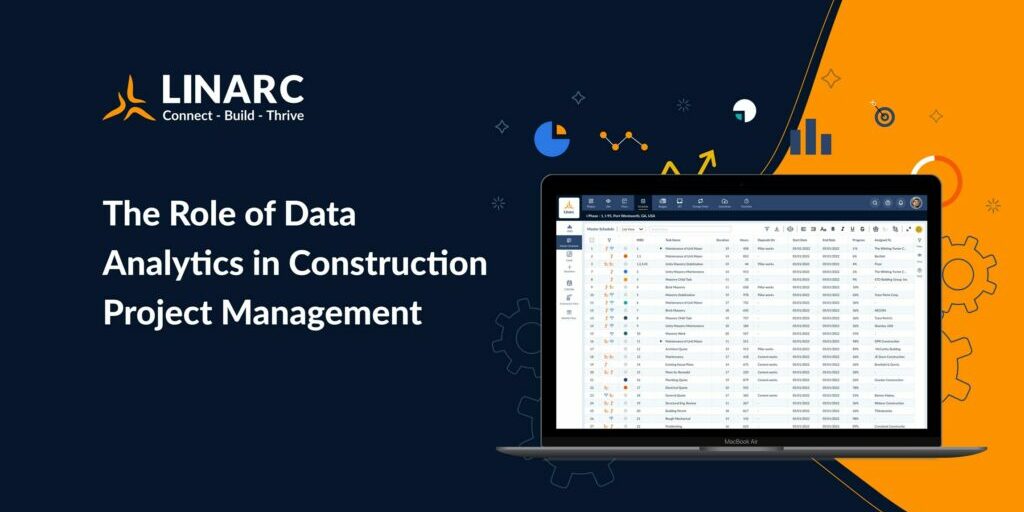4 Ways Data Analytics is Optimizing Construction Project Management

In today’s technology-driven landscape, data analytics is crucial to organizational excellence. Data analytics can help solve many problems, including mismanagement, cost overruns, budgeting, low ROI, and quality control issues. Often, these challenges have multiple variables.
Data analytics accurately reveals these variables, empowering project teams. By taking a data-centric approach, construction project management teams can significantly improve business intelligence and have more profound insights into site conditions, design materials, resources, budgets, and more. This, in turn, enhances project performance, optimizes resources, and mitigates risks.
Here’s what we cover:
4 Benefits of Using Data Analytics in Construction
Construction project management teams juggled many moving pieces daily at every job site. Project decision-makers must collect and analyze data to make informed decisions. Manual data collection processes are time-consuming and prone to human errors.
Data analytic software helps solve the construction industry’s data management problem, boosting bottom lines, improving accuracy, and maximizing time and resources.
Here are the top four benefits of data-driven decision making to improve construction project outcomes.
1. Improve Project Planning and Performance
Advanced data analytics allows project managers to drastically improve construction project planning, resource allocation, and performance monitoring. They can glean valuable insights into labor hours, use of equipment, and materials purchased.
This fosters data-driven decision-making, enabling project management teams to identify key patterns and trends that unearth better strategies. Project managers can use previous project data to learn what worked and what didn’t work in the past, including budgets, schedules, and resource utilization.
2. Optimize Resources
Designing and building massive buildings involves a considerable amount of matching and calculations. Data analytics allows project owners to maximize their resources, including materials, designs, and budgets. They can use data to choose the best suppliers, improve the allocation of resources, better manage and track tools and equipment to prevent loss and theft, and enhance schedule performance by pinpointing potential delays and plan changes.
3. Mitigate Risks and Enhances Quality Control Measures
Safety risks run rampant on construction sites. As such, project managers must identify and prevent potential perils accurately. However, many safety hazards can be tough to spot, even with the most detail-oriented eyes. Project managers must capture and analyze data to mitigate safety risks by defining and implementing efficient on-site safety guidelines.
They can closely examine risk assessment and incident reporting data to map out high-risk areas on the job site and build a plan that reduces risks.
Additionally, construction data analytics can improve quality control, allowing project owners to achieve high-quality standards. They can easily complete detailed measurements and inspections, uncovering crucial patterns and trends that indicate opportunities for improvement and potential challenges.
Lastly, state-of-the-art analytics tools allow construction firms to bolster data security, keeping sensitive information safe.
4. Controls Project Costs
One of the most prominent problems construction companies face is cost overruns. Accurate budgeting and planning are essential for controlling costs and preventing overruns. Data analytics improves budget management, which minimizes costs without compromising quality.
Advanced data analytics helps project managers to oversee budgets efficiently. They can keep track of cost revisions, estimates, and change order impacts, staying in complete control of project costs.
Key Types of Construction Industry Data
There are numerous types of data that are pivotal to managing construction projects. However, with no shortage of data, project teams must collect and analyze the proper data sets to ensure project success.
The top types of data that construction companies must capture, analyze, and backup include:
- Project blueprints
- Design models
- Budgets
- Available materials and resources
- Project scope, measurements, and timelines
- Construction plans
- Site surveys
- Permits
- Vendor, staff, and client information
Losing and not sufficiently analyzing this data could hinder a project’s outcome and a company’s time, money, and reputation. That’s why it’s essential to store data in a safe, accessible, unified location, such as Linarc’s cloud-based construction management software platform.
Linarc’s Powerful Data Analytics Empower Construction Project Management Teams
Data analytics is a game-changer for construction teams. It can improve project planning and performance, reduce costs, maximize resources, and keep workers safe.
To reap these rewards, construction firms must embrace the right project management software and data-driven approaches. Spreadsheets won’t cut it anymore.
Linarc’s world-class construction management platform empowers project teams to optimize the outcomes of all projects. With Linarc, you can now manage projects collaboratively, minimize delays, reduce risks and cost overruns, manage budgets, keep data secure, and make confident, informed decisions.
Learn how Linarc can enhance your construction projects with advanced data analytics solutions. Contact us today for your free custom demonstration.




